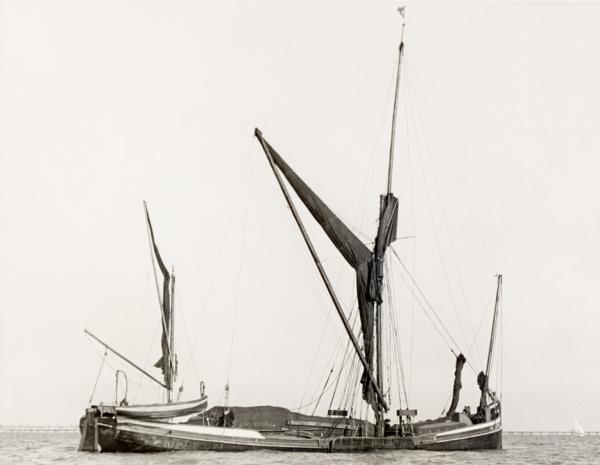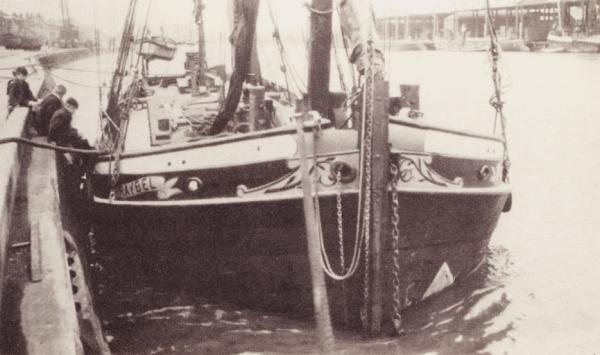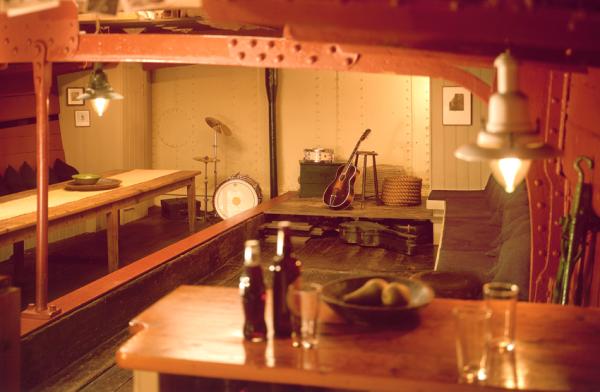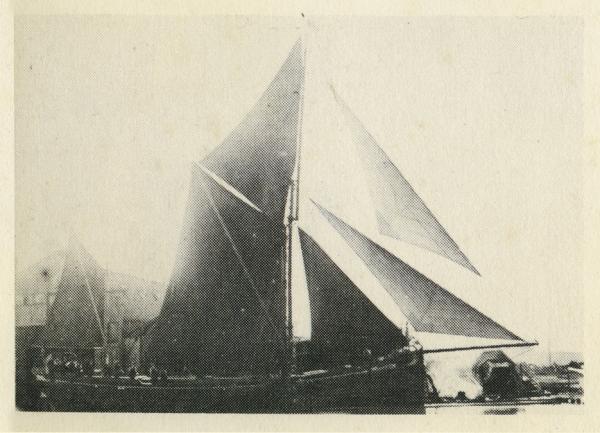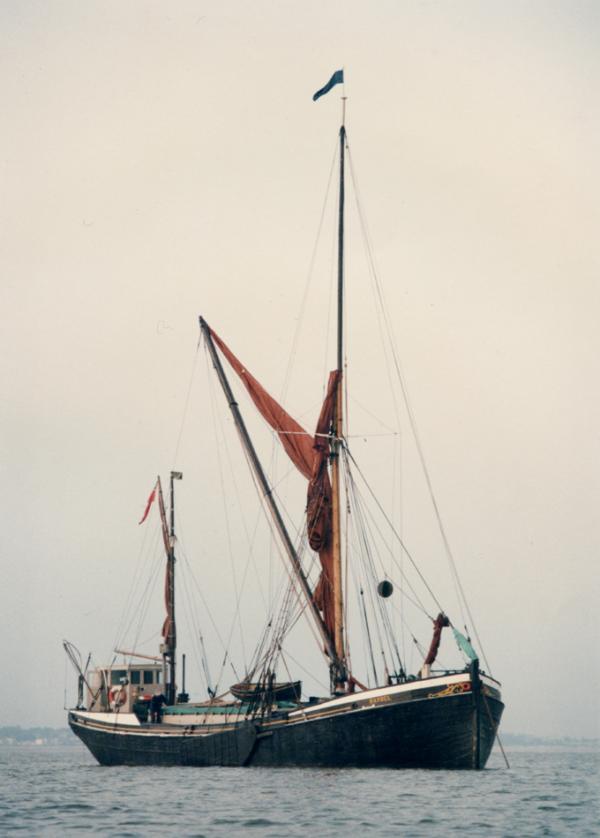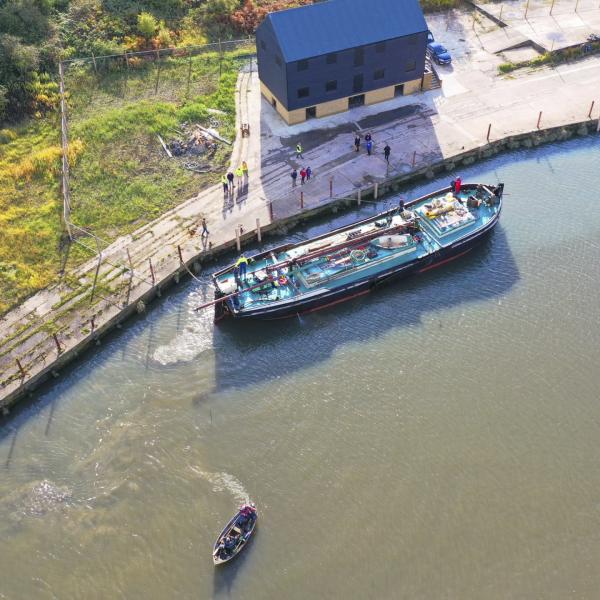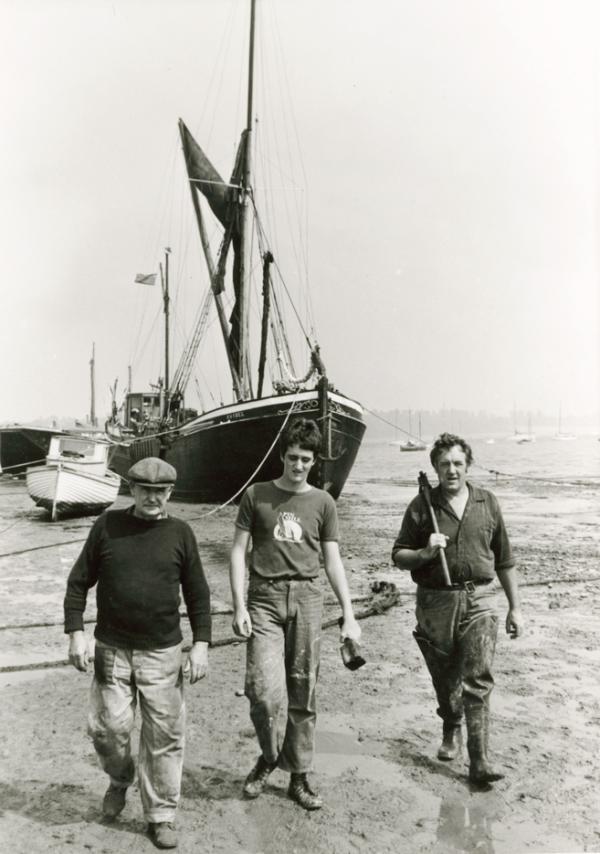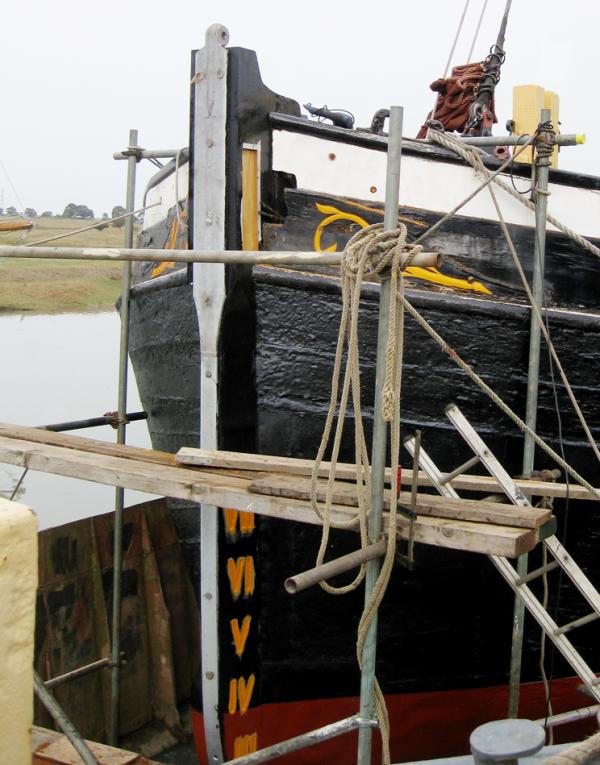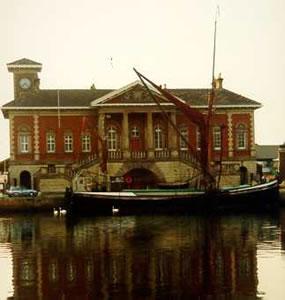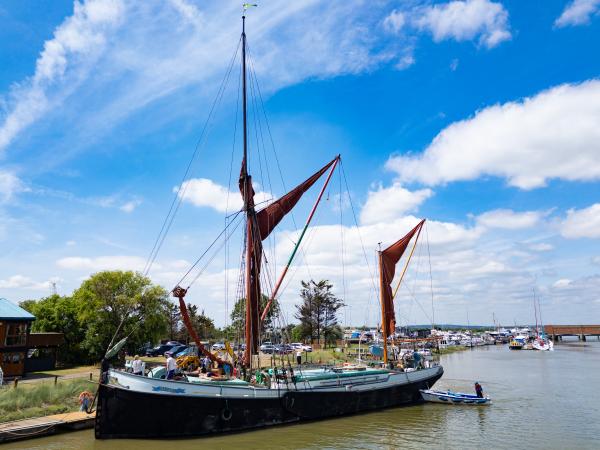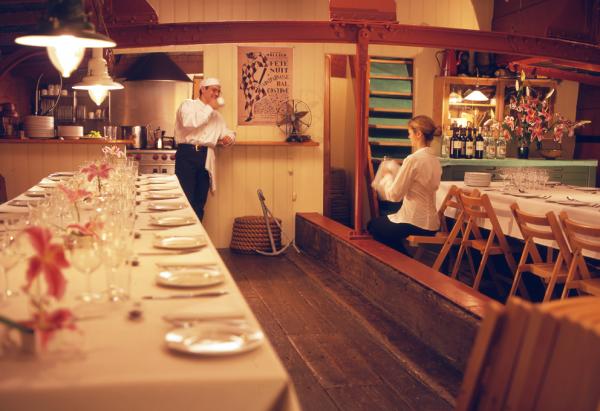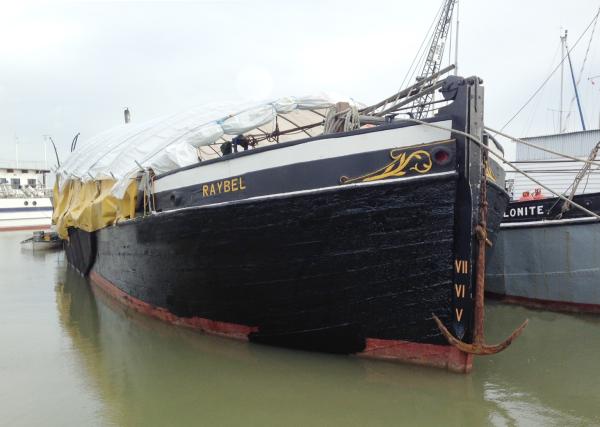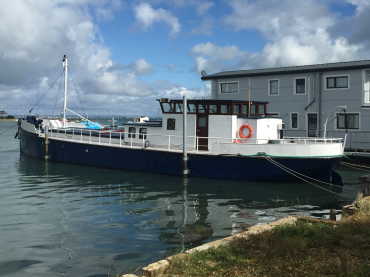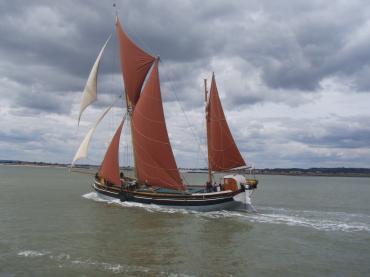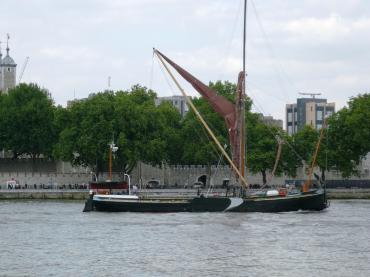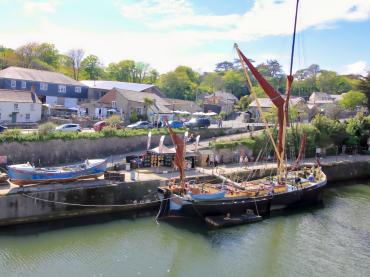

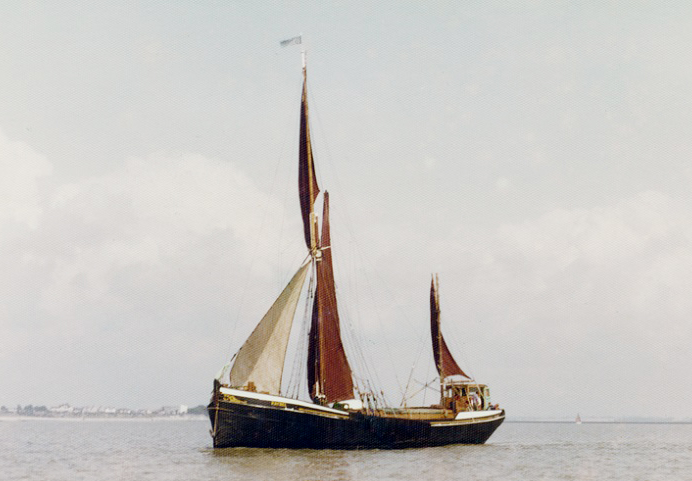
Details
Construction
Dimensions
History
Built in 1920 by Wills and Packham at Milton Creek, Sittingbourne, as a coasting barge for G F Sully, of London, RAYBEL is of composite construction, mainly of wood but with iron beams and steel keelson, knees and carlings.
The name ‘Raybel’ was derived from the twins Raymond and Isabel who were born to the Sully family earlier that same year. While still on the yard it was decided, by the Sully family, that the barge would be used for summer holidays with their children. A large after cabin skylight of teak and brass, with seating on either side, was fitted. By all accounts this was very splendid and can be seen in the early photographs. The Raybel became the pride of the Sully fleet and soon earned the nickname ‘Sullys Yacht’.
Bernhard Sully had ordered a powerful coasting barge of 86 feet from stem to stern post and with a cargo capacity of at least 150 tons. The intention was to have the ideal barge for their increasing trade to and from Belgium, France and Holland. And so it was no accident that the high bow and sweeping sheer of Raybel, unusual in a sailing barge, is reminiscent of fishing boats working the North Sea.
Soon after the outbreak of WWII Raybel was commandeered by the Admiralty and for the remainder of the war worked from the Clyde, Scotland as supply ship to naval craft. On the voyage to Scotland Raybel just managed to pass through the Crinan Canal and thus avoid the passage round the Mull of Kintyre. To achieve this the leeboards were shipped onto the main hatch.
An auxiliary engine, a Kelvin 88, had been fitted for the work in Scotland and after the war Raybel continued to deliver all manner of cargos between London and east coast ports as well as the near continent. Albert Webb was skipper and, in 1949, Jim Lovegrove, a talented artist, made occasional passages as trainee hand whilst studying at the Royal College of Art, London. In 1951 he was taken on as mate and kept journals and notes of the freights carried. However, on 28th January 1953 Raybel was run down by steamship Swiftsure in the Thames off Greenhithe. Jim Lovegrove was not on board but both skipper and temporary mate survived and, through quick work, the barge was towed to shallow water and saved. Some of the journals and artworks were ruined but detailed records of cargoes delivered in the early ‘50s remain. Raybel was repaired at St. Clements Yard, Ipswich where a new transom was fitted together with frames, whale, and planking to the port quarter. Jim Lovegrove went on to sail with the now legendary explorer Major H.W.Tilman. In 1957 he answered an advert in the Times which read ‘Hands wanted for long voyage in small boat: no pay, no prospects, not much pleasure’. He joined the crew of “Mischief”, a 40ft Bristol Channel Cutter built in 1908.
RAYBEL continued in Sully’s ownership until 1974 when she was sold to the artist Ian Houston, who later gained a master’s certificate in order to study sea, weather and traditional sail in action aboard RAYBEL.
By the early 1970s most barges had been retired from freight carrying. Due to economics, the smallest – and oldest - were the first to go.
Ian Houston bought RAYBEL on the advice of Reuben Webb of F.A. Webb & Sons barge yard of Pin Mill, Suffolk. His brother, Albert Webb, had been one of the longer serving skippers and he knew the particular strength and good condition of the barge. When it became apparent that there was still freight delivery work available Ian Houston founded Raybel Charters and in May 1974 Raybel returned to trade under skipper Douglas Bridges. The work continued for two years with cargoes including wheat, starch, haricot beans, pitch, and flour.
When freight charters became increasingly difficult to find, RAYBEL returned to Webb’s yard where sailing gear and rigging were refitted. The pitch pine mainmast and sprite, together with wire rigging and leeboard winches, were sourced from a much older barge – ASPHODEL. A new suit of flax sails were built by Whitmores of Ipswich in the autumn of 1976; the last suit of barge sails this once busy sail loft produced.
A restoration project was conceived by new owners in 2016/17, and Raybel Charters Community Interest Company established in 2018. A first round pass from the Heritage Lottery Fund was secured in June 2018, and final approval for the project was received in June 2019.
RAYBEL was moved to Milton Creek in September 2019. A dry dock kindly donated by the Westmoreland Trust was raised from Upper Halstow creek and moved to Milton Creek in March 2020. Due to Covid 19, work could not start on the dry dock until later that year and RAYBEL was inserted in October 2020.
Shipwrights Tim Goldsmith and John Hall started the restoration work in March 2021, with Laurie Watkins joining in November 2023. RAYBEL was refloated with all structural work completed, in May 2024, 104 years after she was built – and just a few hundred yards up Milton Creek from the Wills and Packham Yard where she was launched in August 1920.
A programme of volunteering, open days, creative workshops and archive research has run alongside the conservation work. The project has been a key component of a new heritage cultural and leisure site at Lloyd’s Wharf on Milton Creek, re-connecting Sittingbourne with its maritime heritage. This has been especially important as a restoration has never been carried out in the town, despite its rich heritage in barge construction.
As of March 2025, the final stages of re-rigging are taking place, and a basic internal fit out is underway. The expectation is that RAYBEL will return to sailing later in 2025, at which point she will be used for sail shipping between Ramsgate and London.
In November 2025, RAYBEL was announced as the Winner of the Martyn Heighton Award for Excellence in Maritime Conservation at the 2025 National Historic Ships UK Awards.
Contact and follow on the Raybel Charters website and @raybelcharters on social media channels.
Significance
1. What is the vessel’s ability to demonstrate history in her physical fabric?
Evidence for designs, functions, techniques, processes, styles, customs and habits or uses and associations in relation to events and people. How early, intact or rare these features are may impact on significance.
RAYBEL was one of the last four barges to be built by Wills & Packham of Milton Creek, Kent and reflects the yard’s work with innovative naval designs during the First World War in her construction. She is a composite build, fitted with extensive ironwork – a steel keelson, iron beams and carlings, plus shaped iron knees, iron straps, increased beams under the mast deck and a removable iron beam in the main hold for loading of bulky cargo. The wide iron plates under the king planks which run the length of both fore and main holds are unique. These increase in number under the mast deck and, together with shaped iron straps into the combings, give her structure extra strength whilst also having the advantage of decreased bulk and weight allowing space for additional cargo. The original ironwork survives today in good condition. The timber fabric of lining, sealing, oak beams (forward and aft), inner whale and chines is more than 95% original. The oak frames are largely original and, where replacement of planking or covering-board has been undertaken, they have been found to be in unusually good condition. External work has been carried out using like-for-like materials and rails repaired over the life of the barge remain true in detail to the original build. The intricate carved bow badges are original, with the scrollwork and name carving being the only changed detail. Nearly 50% of the deck is original and, where replaced, traditional methods of caulking with oakum and pitch have been used. The combings are original and retain the heightening timbers added in the 1930s. The oak transom was replaced in the 1950s, but this has been documented in photographs and was carried out in oak as per the original, with exact replication of scrollwork. Of the rig and deck fittings, the windlass-core and coasting winch are original. Replacement spars and rigging have been made to original size and the leeboard winches are from an earlier barge. The ships wheel (heavy teak and brass) is original, as is the unusually large compass. Doors have been made into the after cabin and foc's'l for a safety exit and ease of access. Both are cut from, and retain, the original bulkhead fabric. A 'companionway' sliding access hatch has been fitted into the boards of the main hatch on the starboard, for'ard corner and the lifting 'hatches' have been halved to enable the continued removal of the portside boards. All other hatch boards, over both main and fore hold, remain original and removable. Because of the high level of internal originality, RAYBEL retains the patina of use. The combings especially bear the marks of many years work and there is evidence of the iron banding inside combings being snagged during unloading. Also 'Sully’s green' paint can be seen on timbers, under the current buff paint. The sealing is totally original pitch pine and has not been touched. Under the mast deck (the most difficult place to unload) are the chips made where the ‘bucket’ has been swung and dropped onto sealing boards. An engine was fitted at the outbreak of the Second World War and a riveted and bolted steel bulkhead added. It is known that there was a diesel oil spillage (1960s) by the aft bulkhead and, as RAYBEL was primarily engaged in carrying food cargo, the after 15' of sealing was doubled with pitch pine to prevent contamination. The Gardner 6LW (marine) was fitted new in 1962 and the original handbook and other documents are retained by RAYBEL Charters CIC. To reduce weight a hydraulic gearbox has also been fitted.
2. What are the vessel’s associational links for which there is no physical evidence? Associations with people or places. Off-ship research.
RAYBEL was built on the upper reach of Milton Creek, Sittingbourne and registered in London. While she principally has connections with the East Coast, work also took her to ports of Britain as well as Holland, Belgium, France. She is unusual in having been managed by just two companies in the course of her history - G.F.Sully and RAYBEL Charters (now CIC). Perhaps largely because of this, her varied activities are well recorded. Her name RAYBEL derives from Raymond and Isabel - born the same year to the Sully family. The sailing barge was used by the family for summer holidays during the 1920s and ’30s and is known to have been the 'pride of the fleet'. During the Second World War, RAYBEL was commandeered by the Admiralty and worked from the Clyde as supply ship to naval craft. In 1949, Jim Lovegrove, a talented artist who studied at The Royal College of Art, made occasional passages as trainee hand, later becoming mate and keeping journals and notes of the freights carried as well as making drawings and paintings. He went on to sail with the now legendary explorer Major H.W.Tilman. RAYBEL has strong local associations to Pin Mill in Suffolk where she was based during her early charter career between 1977 and 1987. At the time, there were three generations of Webbs running the barge yard. Reuben Webb grew up on sailing barges, his father also being a skipper. His brother Albert was one of the longest serving skippers of RAYBEL and Reuben got to know the barge well and passed on many details and anecdotes. RAYBEL was purchased by the landscape and marine artist Ian Houston in 1974 and continued delivering freights under the new name of RAYBEL Charters. From 1977 RAYBEL began weekend and week long sailing trips, for up to 12 people, with the focus on drawing, painting and observation of the natural world. By 1981 RAYBEL was increasingly working from The St. Katharine Docks, London and during the 1990’s began hosting a wide variety of quayside events; educational activities, corporate hospitality, exhibitions, etc.. Experimental theatre events in conjunction with new writers and directors were especially successful. RAYBEL has featured in a number of published works and films, and is well documented in written accounts and photographs. She has been recorded on the National Register of Historic Vessels since 1996.
3. How does the vessel’s shape or form combine and contribute to her function?
Overall aesthetic impact of the vessel, her lines, material she was built from and her setting. Does she remain in her working environment?
The primary function of RAYBEL was to deliver cargo between Thames Estuary ports, with some longer passages in heavier seas to the ports of Holland, Belgium and France. This is evidenced in her composite build, the increased sheer and shape of the bow as well as the high bow rails and long quarter boards. As a powerful coasting barge, rigged with bowsprit and her original lofty gear, RAYBEL has an appearance of strength and elegance. Her use as a ‘holiday yacht’ by the owner’s family can be seen in details such as the very splendid after hatch and seating of teak, brass and glass, the tapered capping on the rails and the particularly fine wheel and large compass and binnacle. Her role as delivery vessel for the Royal Navy during the Second World War saw an engine installed along with a riveted steel aft bulkhead which remains, including the Kelvin 88 engine beds. Below decks, there is an apparent lightness in the iron beams, keelson and carlings, which gives an elegance to RAYBEL’s holds. Both forward and aft the decks and hatches are high and even under the lowest beams and on the side decks there is headroom of six feet.
Source: vessel owner, February 2018, updated August 2023.
Key dates
-
1920
Built by Wills & Packham of Sittingbourne, Kent for owner, cargo company G.F.Sully. Begins trade on Thames, east coast ports to Ipswich, and the near continent
-
1939
First engine fitted – a Kelvin 88 – when RAYBEL is commandeered by the Admiralty for war work on the Clyde
-
1949
Jim Lovegrove, artist studying at The Royal College of Art, makes occasional passages on RAYBEL as trainee hand, documents voyages and paints seascapes from RAYBEL deck
-
1953
On 28th January, RAYBEL was run down by steamship SWIFTSURE in the Thames off Greenhithe. Repaired at St. Clements Yard near the Ipswich docks
-
1959
By the end of the 1950s RAYBEL still carries her mains’l but top mast, mizzen and bow sprit are gone
-
1960s
Repairs lead to RAYBEL’s bow rails being removed and replaced
-
1962
Fitted with a new engine – a more powerful and efficient, Gardner 6LW to replace the Kelvin 88. This is the engine still on board today
-
1974
Ownership passes from Sully’s to painter Ian Houston and family. Raybel Charters established. RAYBEL continues in freight work with orders now coming from Crescent Shipping, including starch, wheat and haricot beans
-
1975
Re-rigging carried out by Reuben Webb of F.A.Webb & Sons, Pin Mill, Suffolk. First time under sail for 25 years
-
1980s and 90s
Deterioration in structural condition of timbers means RAYBEL spends increasing time as a static barge in St Katharine Docks. Finds a new life as an acoustic music, theatre and events space
-
2011
Engine restoration at Standard Quay Faversham, before being moved to Pin Mill, Suffolk. Cover constructed to ensure protection as sailing no longer possible. Ownership passed to Rob Sargent. Moved to Heybridge Basin, Essex. Continued maintenance undertaken, and some restoration work undertaken including portside bitt head renewal and repair and replacement of areas of side, forward and sailing decking. New mainsail completed by sail maker Mike Putt
-
2016
Initial concept of forming a social enterprise developed by founding directors Gareth Maeer, Rob Sargent and Ian Houston. Focus on community development and sail cargo. First contact made with the Sail Cargo Alliance
-
2017
Outline business plan produced and contact made with HLF. First round of consultations carried out, with local government, maritime heritage organisations and local community groups
-
2018
Raybel Charters Community Interest Company formed. Ownership of SB RAYBEL transferred to the CIC. HLF first round application submitted and approved
-
2019
HLF second round application approved. RAYBEL moved to Milton Creek from Heybridge Basin in September
-
2020
Dry dock donated by the Westmoreland Trust raised from Upper Halstow creek and moved to Milton Creek. RAYBEL inserted October 2020
-
2021
Shipwrights Tim Goldsack and John Hall started the restoration work, with assistants Josh Goldsack, Reuben Hopper and team of around 40 volunteers, over the next three years
-
2023
Laurie Watkins joins shipwright team in November 2023, replacing Tim Goldsack
-
2024
RAYBEL refloated with all structural work completed, 104 years after she was built – and just a few hundred yards up Milton Creek from the Wills and Packham Yard where she was launched in August 1920
-
2025
Announced as the Winner of the Martyn Heighton Award for Excellence in Maritime Conservation at the 2025 National Historic Ships UK Awards.
Sources
Chancellor, F & S, Cooper, John, A Handbook of Sailing Barges, 1955
Pipe, Julia, Port on the Alde; Snape and the Maltings, 1984
Alan & Williams, Cordell, Leslie, The Past Glory of Milton Creek, 1985
May, Dinah, Surviving Michael Winner; A Thirty Year Odyssey, 2014
Benham, Hervey, Spiritsail Barges of Thames and Medway, 1948
Brouwer, Norman J, International Register of Historic Ships, Anthony Nelson, Edition 2, 1993
Carr, Frank, Sailing Barges, 1971
Hugh Perks, Richard, Sprts'l: A Portrait of Sailing Barges and Sailormen, Conway Maritime Press, 1975
Wood, D G, The Last Berth of the Sailorman, Society for Spritsail Barge Research, 1987
Wood, D G, Barges Sailing Today: Sailing Barge Information Pamplet No: 1, Society for Spritsail Barge Research, 1995
March, Edgar J, Last Stronghold of Sail, 1948
Own this vessel?
If you are the owner of this vessel and would like to provide more details or updated information, please contact info@nationalhistoricships.org.uk

